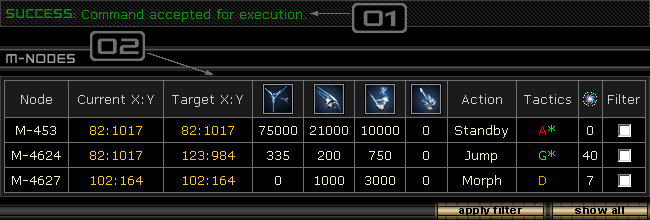The Y-Unit is the basic unit of the Krong. It consists of billions of nano-elements joined by energy force fields. Y-Units can be used as bombs by breaking their energy joints resulting in an explosion.
Y-Units can extend in subspace making an energy network that will permanently scan the area and give you the information. All other units are conglomerates of Y-Units, connected by powerful force fields. Because all units are structures of Y-Units they can be disassembled back into
All M-Nodes cannot land on a planet, because of their structure. But they successfully can jump with acceleration, using additional Energy.
All Krong nodes don't travel in space actually. They jump from one point to another practically instantly. But before jumping they will need time and Energy to modify space continuum for it. This is the most vulnerable time for Krong as it cannot defend itself.
Time of jump preparation depends on used Energy. M-Nodes cannot jump from one star system to another star system with acceleration. The main purpose of M-Nodes is the protection of I-Nodes and a few other functions.
From this page you'll be able to command your M-Nodes. In this screen you'll get a list of all M-Nodes with specific info such as current and target positions, the amount of Y-Units, U2, U3 and U4, node action, etc.

 Action result message.
Action result message.
 M-Nodes list with additional information for each of them.
M-Nodes list with additional information for each of them.

 Orders form.
Orders form.
KRONG - M-Node Tactics
STANDBY Action
This action will cancel all previous actions (except morphing) and put the M-Node in idle state.
JUMP Action
Make an M-Node to jump to another location. Your M-Node cannot jump from star system to star system with acceleration. If you'll use acceleration, extra Energy will be used.
SCAN Action
This action will force your Y-Units to create an Y-network in specified coordinates. Usually used for "exploring" new star systems.
MASS SCAN Action
This action is similar to the previous one, but it allow to scan multiple star systems. You must indicate how much Y-Units node must send for scanning. The systems will be taken sorted by distance from the selected node. You will see short notification about how many systems is possible to scan and after executing the action - how much systems were scanned.
BOMBARD Action
Will bombard specified planet (gven by coordinates and orbit). M-Node has to have Y-Units. Only
ATTACK Action
Will attack a specified Empire. Just insert the Empire ID and your M-Node will attack any fleet of the targeted Empire that will pass your position (exept alies and Empires from alliances you have NAP).
E-STORM Action
Will hyper to the target coordonates huge ammount of Energy using U3 units. U3 are destroyed after this action. You can use extra Energy to increase damage to the target. Only Mercenary Cloaking and Propulsion modules and Fagur hordes and Fagur Eggs are affected by E-storm. Also, E-storm damage depend from distance to the target and drastically fade to 0 in star system.
COLLAPS STAR Action
Make a star to collaps and transform it into a Black Hole. Be aware that all nearby stars in range of the new Black Hole will also collaps. You will need U4 units in your
Note: Only stars of classes O, B, A, F can be directly collapsed - other stars can collaps only during chain reaction. Formed Black Hole can be merged with surrounding stars of other Black Holes. Newly formed Black Hole`s power and coordonates depend from absorbed stars and Black Holes.